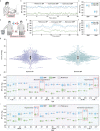Thin, soft, wearable system for continuous wireless monitoring of artery blood pressure
- PMID: 37591881
- PMCID: PMC10435523
- DOI: 10.1038/s41467-023-40763-3
Thin, soft, wearable system for continuous wireless monitoring of artery blood pressure
Abstract
Continuous monitoring of arterial blood pressure (BP) outside of a clinical setting is crucial for preventing and diagnosing hypertension related diseases. However, current continuous BP monitoring instruments suffer from either bulky systems or poor user-device interfacial performance, hampering their applications in continuous BP monitoring. Here, we report a thin, soft, miniaturized system (TSMS) that combines a conformal piezoelectric sensor array, an active pressure adaptation unit, a signal processing module, and an advanced machine learning method, to allow real wearable, continuous wireless monitoring of ambulatory artery BP. By optimizing the materials selection, control/sampling strategy, and system integration, the TSMS exhibits improved interfacial performance while maintaining Grade A level measurement accuracy. Initial trials on 87 volunteers and clinical tracking of two hypertension individuals prove the capability of the TSMS as a reliable BP measurement product, and its feasibility and practical usability in precise BP control and personalized diagnosis schemes development.
© 2023. Springer Nature Limited.
Conflict of interest statement
The authors declare no competing interests.
Figures




References
Publication types
MeSH terms
LinkOut - more resources
Full Text Sources
Medical

